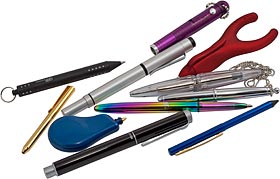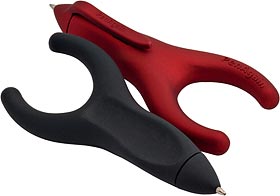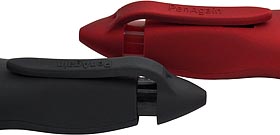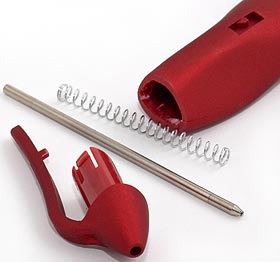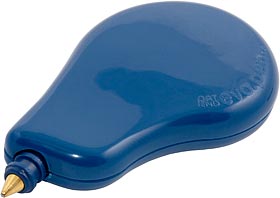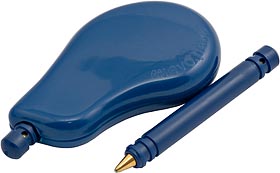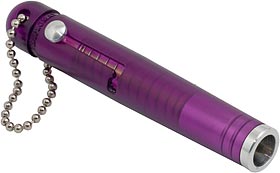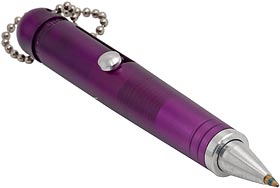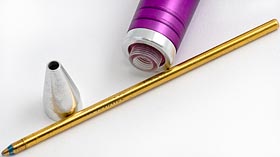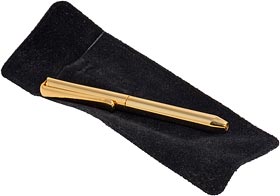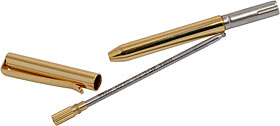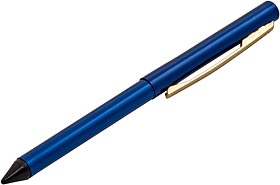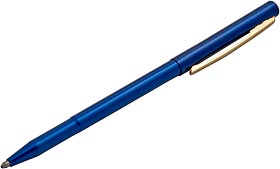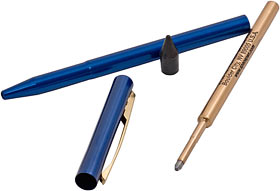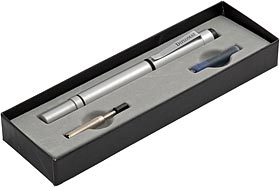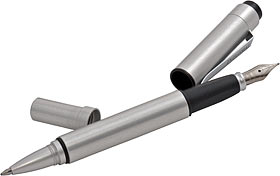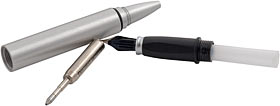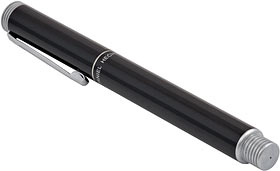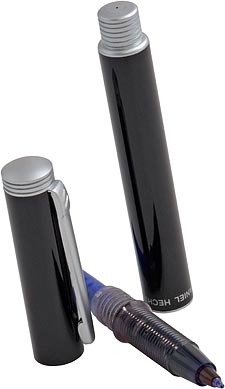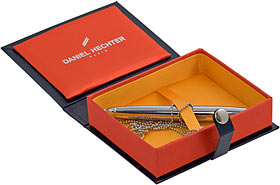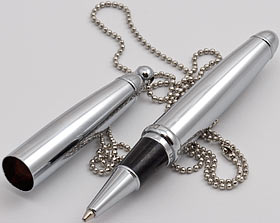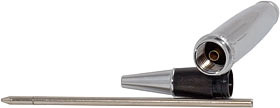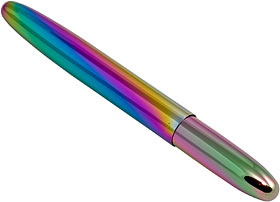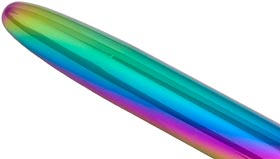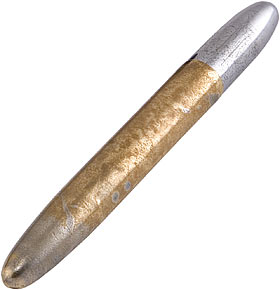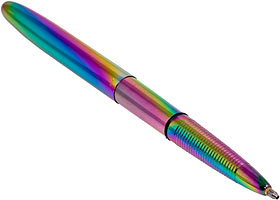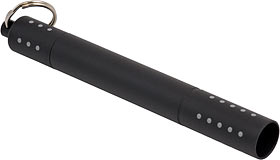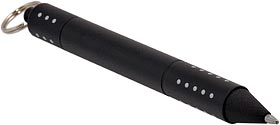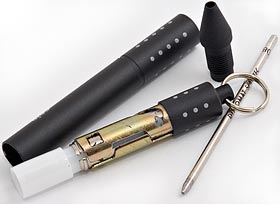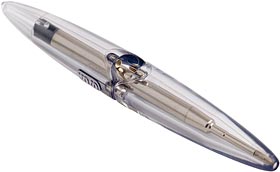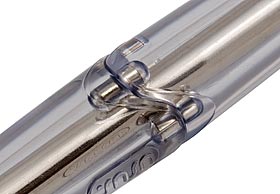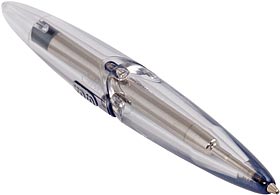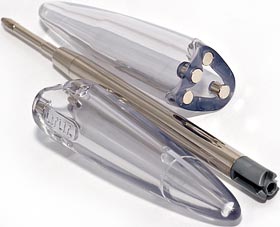
Peculiar pens
Review date: 8 February 2006 Last modified 03-Dec-2011.
From many people's point of view, the pen has reached the end of its evolution. After ballpoint prices fell to the point where you could stuff a pillow with 'em for twenty bucks, the mass market needed nothing more.
Most modern pin
pen collectors
are into fountain pens, possibly because there just doesn't seem to be much happening at the cutting edge of pen technology
any more.
There are, however, people who're enthusiastic about other areas of ink delivery technology, like for instance the various idiosyncratic products that come out of Japan. You can buy esoteric stationery from all over the world online; JetPens is a popular store for people hunting odd Japanese products like the hyper-minuscule 0.18mm Signo Bit and white-ink gel pens, which I had to buy just to see what they were like (superfine pens work surprisingly well as long as your paper is smooth; white gel ink much appreciated by artistic sister).
And then, there are the people for whom no pre-made product is adequate.
But you could come back with an awful lot of gold if you took a crate of yellow Bic ballpoints back in time a thousand years. Basic ballpoints do their job very well, and they cost many people exactly nothing.
Common ballpoints are not, however, objects with which you are likely to fall in love. If you write (or draw) a lot, you probably want something that feels nice to hold and use, which cheap ballpoints don't. You want smooth, even ink flow, which cheap ballpoints... often manage. And you may want other features. A pen that won't barf all over your luggage at 38,000 feet. That'll fit comfortably in your pocket, small purse or even wallet. That absolutely will not block up.
Or, very importantly, maybe you just want a pen that's fun to play with. Survey the activities people perform at school and office, and a big slice of that pie graph's going to be labelled "fiddling with stationery".
The basic Bic ballpoint is not, of course, the only cheap pen option these days. But there are plenty of more peculiar products out there.
Here are a few.
By Grabthar's hammer!
Pens are the shape that they are not because that's especially comfortable, but because that was the shape of reeds and quills, and because dip pens had to be able to reach the bottom of the inkwell.
(Also, funny-shaped pencils aren't easy to use when you've sharpened half of them away.)
Various squishy grips and contoured sleeves and other gadgets aim to make it easier for humans to write with stick shaped things, but modern ink cartridges are small enough that a pen doesn't actually have to be that shape at all.
So the PenAgain isn't.
I could take a picture of a hand holding the PenAgain, but the one on the PenAgain site should give you the idea. You hold it with its pocket clip downwards, your index finger resting in a smooth depression, and your thumb and middle fingers holding it on either side. The bifurcated part of the PenAgain rests against your second proximal phalanx, so you push it onto the paper directly with the weight of your hand, not indirectly through a white-knuckled grip on its sides. The gripping fingers don't have to hold on any harder than is necessary to control the tip, which is orders of magnitude less force than you need to keep an ordinary slippery ballpoint in place.
Hence, ergonomic niceness. If you write a lot and get a sore hand, or if you have some strain injury that makes it painful to hold a pen for any significant period of time, or if your hand just isn't strong enough to hold onto a pen, I feel pretty safe in saying the PenAgain will be a revelation to you.
It also feels nice. This is the "Ergo-Sof" version of the PenAgain, which has a thin, smooth, rubbery coating. The packaging has a hole to let you fondle it. It's also got a satiny finish that makes the more lushly coloured versions (you can have a PenAgain with a red, blue, silver, or black body) look downright sexy.
Yes, you can retract the tip; you just lift the end of the pocket clip and a spring pops the nose of the PenAgain closed.
The pocket clip, by the way, is more useful than some. The PenAgain is only a bit over four inches in length, so it'll actually fit into all but the shallowest of pockets without bottoming out, and is less likely to unclip itself and fall on the floor if you clip it to your belt, or something, and then sit down.
It's easy to take the PenAgain apart to change the ink cartridge.
The PenAgain feels like an ordinary decent-quality ballpoint when you're writing with it, except you don't have to clamp a stick between your fingers. There's virtually no learning curve, since you're still guiding the pen with the same fingertips you normally use.
It's not terribly expensive, either; here in Australia, it costs $AU15 including delivery within Australia from the JustWrite Pen Company, who provided all of the pens in this review. They deliver outside Australia, too, for a flat fee of $AU12, and offer a no-questions-asked 14-day money-back guarantee.
The PenAgain takes a standard size of refill (and will work with Diplomat's long and skinny Space-Pen-style pressurised refill, about which more shortly), but you won't need to buy one for a while, since it comes with two cartridges.
The only problem with the PenAgain that I can see is that it hasn't got much Fiddle Value. You can fondle it, you can click the end up and down and drive your officemates bananas, you can take it apart and put it back together (the unusual closing mechanism makes it very easy to reassemble the pen wrongly and propel the spring across the room, but the pen still works fine without it), and there are no doubt various new and interesting spinning tricks to be done with this new piece of equipment - but you can do all of these things with ordinary pens. For something so unusual in appearance, the PenAgain is a disappointing toy.
Oh, and it's "guaranteed to be the most unique gift you have ever bought for yourself or for a loved one".
If you're all boring and just want to write stuff, though, the PenAgain's great.
Compare and contrast
The Evo Pen (whose manufacturers seem to want us to call it the evo.pen, but I think that is stu.pid) isn't as flashy as the (rather younger) PenAgain, but it has the same purpose.
You hold the Evo Pen with your index finger curled around it, and it thus works in much the same way as the PenAgain. The part you grip is taller (giving the last joint of your middle finger a flat surface to rest against), but it still doesn't feel particularly weird. And, once again, the feel of the tip on the paper is unremarkable - but the feel of your hand not hurting after a ten page essay may be. The Evo Pen's received various commendations from people who should know about ergonomics.
The Evo Pen has a non-standard ink cartridge, but the company's been making the things for more than a decade and so refills shouldn't be hard to find (they're $AU6 for three from JustWrite). You get two blue-ink cartridges with the pen (they also come in black); to "close" the pen you just pull the plastic-sleeved cartridge out and stick it back in the other way around.
The Evo Pen's very small - it'll fit snugly in the "Zippo pocket" of a pair of jeans. It costs $AU15 delivered within Australia, the same as the PenAgain, unless red or blue plastic isn't good enough for you and you decide to splash out on the chrome version for $AU60.
The Evo Pen's been around quite a lot longer than the PenAgain, and has collected enough accolades in that time to seem to be the better choice, if you're arthritic or carpal-tunnel-afflicted or otherwise very definitely in the market for one of these things.
The PenAgain, however, needs even less grip force than the Evo Pen (which still has to be held laterally a little bit, to stop it sliding out from under the pad of your finger). Unless there's some hidden ergonomic disaster in having the PenAgain prongs sticking up around your finger, I'd go with the Y-shaped pen. The two cost the same, but the PenAgain's nicer to look at and hold. And, I'm sorry to say, the Evo Pen's almost a dead loss in the fiddle-toy department.
Snick-click
At last, a fiddle-toy. Well, of sorts.
The Diplomat Slide Pen has a spring-loaded cartridge that wants to sit inside the pen's barrel. To deploy the tip you slide a shiny button on the outside of the pen down...
...and then across, to lock it in place. Slide the button back out of its locked position, and the tip snaps back into the pen.
The Slide's available in a selection of strangely named translucent colours, costs $AU15 delivered, and comes with a little ball chain so you can hook it onto your keys, or whatever. It's another pen that feels normal to write with (it takes a standard refill type), but it's not terribly comfortable to hold.
That's because the Slide is not a big pen. With its point deployed, it's only a bit over four inches in length. A person with normal-sized male hands therefore isn't quite going to be able to get the Slide to rest comfortably across the whole of the thumb/index finger junction. And if you've left the little ball chain on it, that'll be tickling your hand as you use the thing. That level of irritation will, of course, pale into insignificance if you've got a bunch of keys attached to the pen as well.
There's some fiddle value here, though; sliding the button and snapping it back is a more impressive procedure than clicking an ordinary retractable pen. You could almost, if bored enough, be working a tiny rifle bolt. So there's that.
Replacing the refill's easy, too.
For fifteen bucks, the Slide wouldn't excite me, except that it comes with a nitrogen-pressurised refill, just like the Space Pens that I will, unsurprisingly, be looking at in a moment (you can also use a standard skinny refill type, if you can't get a pressurised refill to replace the stock one when it finally runs out).
JustWrite also have six and twelve packs that bring the price down to $AU12 and $AU10, respectively, per pen.
If, therefore, you want a small and really high reliability pen on the (relative) cheap, the Slide is a definite option.
It's got a kind of medical feel to it, though, if you ask me - it looks as if it should be hanging around a nurse's neck (where it'd be useless if she didn't take the whole neckband off, but you get the idea) or sitting in a GP's surgery with the name of a drug printed on it.
If you're looking for a short pen that'll fit anywhere, and don't care about writing in zero gravity at high altitude, there are other options.
Toothpick time
You can get this, for example.
The brilliantly named Wallet Pen is only 79mm long (3.1 inches) and 6mm wide (under a quarter of an inch); a bit wider across its rather springy pocket clip. It's got a bit of weight to it, thanks to all-metal construction. That, and its lifetime warranty, makes the $AU20 delivered price tag easier to bear. The gold finish should last pretty well, too; it's brass with clear lacquer over the top.
The Wallet Pen comes in a little velvety pouch, presumably so that you can find it. But it's meant to fit, as the name suggests, in a wallet. Or pretty much anywhere else. This is about the smallest pen you can get that doesn't pull out of the end of a Swiss Army knife.
Turn the Wallet Pen's barrel and the tip extends smoothly. The pen writes like various other better-than-basic ballpoints, thanks to its standard mini refill (black ink, by default).
You can't, of course, hold the Wallet Pen terribly comfortably unless you've got teeny tiny hands, but this thing's for signing cheques and making shopping lists, not longhanding the next Harry Potter phonebook.
Replacing the cartridge is easy enough. Pull pen apart, unscrew brass knob, pull friction-fit knob off cartridge (which I haven't done yet, in the above picture).
In case keen-eyed readers are wondering, the refill in the picture also still has its factory-applied blob of protective waxy plastic on the end. JustWrite tell me that these pens come from the factory with a craptacular cartridge in them - JustWrite replace it with a proper cartridge before they consider the pens fit for sale.
The Wallet Pen is elegant and simple and gets the job done. But it's not the only option in the abbreviated writing instrument market.
Double-header
This is Fisher's Stowaway, the smallest pen made that takes one of the famous Space Pen cartridges. I've talked about Space Pens before, as have many other people over the decades; they use gummy thixotropic ink forced out of the cartridge by compressed nitrogen, and, as the ad copy goes, they write upside down, underwater and in space.
You can put an ordinary Space Pen refill in any pen that accepts a standard Parker cartridge, and they make a variety of other refills to suit most other pens. So why should you spring for a Stowaway?
Well, this is the deluxe version of the Stowaway. It costs $AU18 delivered, and starts out looking like an eyebrow pencil, because it's got a slippery plastic PDA stylus point on one end (JustWrite have the non-stylus version too, but it costs the same).
Swap the cap to the other end and you've got your standard Fisher point. The Stowaway's five inches long, now (it's a tad more than four inches in stylus mode), so you can write with it reasonably comfortably. It's only a quarter of an inch thick, though, so it's still not ideal for lengthy epistles. But it beats the heck out of the Wallet Pen. At the price of... probably not fitting in your wallet.
Fisher make cartridges with different ball sizes and ink colours, but no Fisher pen is a star in the writing comfort department. They're more than good enough, but the super-thick ink creates more drag as you write than you'll feel with an ordinary ballpoint.
Fisher pens all give you an even line and don't blob or block (though they may need a little scribbling to get the ink moving if you haven't used them for a while), and they absolutely, positively let you use all of the ink in the cartridge every time, and they don't leak at low pressures or refuse to deliver ink at high pressures (which is part of the "underwater" thing). This makes them ideal as your everyday carry-around pen, and the Stowaway will take up practically no space in even a small purse, and will write a lot longer on one cartridge than standard mini-refill pens like the Wallet Pen. Actually, you'd probably be able to fit a Stowaway into a large-ish wallet, as well, but it might poke holes in the leather.
So, not a bad option. But the Stowaway's another loser in the fiddle-toy department, and not too exciting to look at, either.
On to another pen with a point at each end.
Both kinds of music
The Diplomat Twin Graph costs $AU85 delivered, but you don't just get a fancy box for your money.
Yep, that's a point at each end. One ballpoint, one fountain.
The fountain pen end-cap presses on, but the ballpoint end-cap screws on, so you can put the first cap on the other end of the pen as normal without the double cap falling off. The balance of the pen is still OK in that mode, but it's a bit better, if you ask me, if you leave the fountain cap sitting on your desk. The pen's made from matte-finish aluminium, and the metal's thick enough to give it a pleasant weight.
The Twin Graph's fountain tip uses standard plastic ink cartridges. You can buy the cartridges pre-filled, or refill them easily enough yourself with a bottle of ink and a syringe. That's what I did, just to try it out, with the empty cartridge that comes installed in the pen. You get one full cartridge with the pen as well, of course, but my Stationery Drawer That Time Forgot has a bottle of ink in it (a product that Parker apparently no longer want to own up to making), which I felt compelled to use.
Diplomat sell a bottled-ink converter doodad for their pens, but it won't fit in the Twin Graph. Never mind; syringes are cool.
The ballpoint end of the Twin Graph uses a special cartridge, but you get one pre-installed and a spare. Since this pen is pretty clearly meant to be a fountain pen with a secondary ballpoint tip, two cartridges should last you a while.
What's the, ah, point of having a ballpoint tip on your fountain pen? Well, you can't write on carbon-copy forms with a fountain pen (unless you've got a very odd one). And a generous flow of wet ink is asking for trouble in some situations - signing a credit card, say.
There is, by the way, clearly meant to be a little spring or spacer or something in the middle of the Twin Graph, but I lost it so quickly after taking the pen apart for the above picture that I can't even tell you what it is. Without it, the ballpoint cartridge rattles a bit and the fountain pen ink cartridge could probably be knocked off if you dropped the pen. A little bit of crumpled paper fixed the problem perfectly, though.
The ballpoint end of the Twin Graph is Yet Another Unremarkable Ballpoint; the fountain pen end is a perfectly acceptable ordinary elastic steel nib. Even a basic fountain pen nib, like this one, feels entirely different to write with than a ballpoint. Because fountain pens work by the same method that causes you to instantly be soaked if your head touches the inside of a canvas tent when it's raining, you need no pressure at all to write with them. This means you don't have to press the pen onto the paper, or hold it very firmly, which makes writing much more relaxing.
On the down side, there's little play value in the Twin Graph. In fact, fountain pens in general have negative play value; if you fiddle with them absent-mindedly you're going to end up with ink all over you. Fountain pens are great for doodling, though.
If all you want is a fountain pen, then you should probably just buy a normal one. Forget the super-expensive giant banana pens from Montblanc and company; it's still easy to find basic fountain pens for a reasonable price. JustWrite have 'em, starting from $AU30 delivered. And it is, of course, also not difficult to find fountain pens in as-new condition for a lot less (Woo! Disposables!). EBay's well stocked with fountain pens of various levels of obscurity; you can get something 50 years old that nobody ever even filled for $US20, if you shop around.
Old fountain pens with rubber-bladder reservoirs can be expected to leak like a sieve, and a pen that's been used regularly by someone else will have a nib that's been worn in a way that won't suit you unless you write at exactly the same angle as the previous owner. But if the virtually unused pen you found in your great-aunt's attic isn't leaky or just plain ready to fall apart, you may not need to do too much for it to be ready to go again.
The Twin Graph, though, is an interesting option for the habitual fountain pen user who occasionally finds themselves in need of a ballpoint. It's a bit gimmicky, but there actually is some purpose to the other point, and it's not ridiculously expensive for what it is.
Rollin', rollin', rollin'...
The Daniel Hechter Rollink costs $AU40 in a selection of colours (mini versions are five bucks less), but at first glance does not appear to be special in any way.
It looks like a pen. It feels like a pen. Take the cap off and all you see is a seemingly ordinary ball point - so ordinary a ball point, in fact, that I haven't even bothered taking a picture of the pen in that mode.
Here the Rollink is in pieces, displaying the unexciting tip. Now you can see what's unusual about it - it accepts a normal fountain pen refill cartridge.
The fountain pen ink gives the Rollink an unusually smooth feel for a ballpoint, as well as a somewhat fountain-pen-ish quality to its line. You can't do fancy calligraphic thick-line thin-line stuff, and you can't use the pen at an extreme angle to the paper, but you also can't bend the tip by using too much pressure, or make a big blotch by mistake.
You're not going to mistake the Rollink for a fountain pen. It's a low-friction ballpen, but still doesn't glide over the paper like a correctly used fountain pen. It's still a pretty slick writing experience, though, at least as smooth as any rollerball pen I've used.
The Rollink is a heavy pen for its size, mainly because of a strangely weighty spot at the closed end of the cap. If you put the cap on the end of the pen while you're using it, it therefore unbalances the whole pen. With the cap just sitting on your desk, the Rollink is nicely balanced but suddenly doesn't feel as expensive any more.
That's OK, though, because the Rollink isn't very expensive. $AU40 is quite reasonable, if you ask me.
Given the price, and the standard refills that you can buy at any vaguely competent stationery store, the Rollink's well worth considering if you like the idea of a ballpoint with something of the feel of a fountain pen, and the kind of bespoke-atelier look that graces stupidly expensive things.
There's not much fiddle-toy value in the Rollink, but it's interestingly hackable. Since it uses an ordinary fountain pen cartridge, you can, once again, use a syringe to fill a cartridge with any ink you like, as long as it won't clog the ball. Most Indian ink or other ink with pigment particles in it therefore probably won't work (fountain pens have the same limitation), but you should be able to use oily dye inks that don't work in fountain pens. Got a refill kit for your dye-ink photo printer? Try syringing some into the pen cartridge, and enjoy writing in pure magenta!
Incidentally, this Daniel Hechter character is alleged to be the inventor of ready-to-wear designer fashion. Apparently, before Hechter came along in the '60s, clothes that came in standardised sizes had no designers. For the 150 or so years before that, mass produced clothes just kinda... happened. Who knew?
This Hechter guy could have invented cotton, of course, and still be of no use whatsoever as regards writing instruments. Fortunately, the Hechter pen line (there's another one coming up...) would appear to be neither a bunch of flashy rubbish nor, as you'd expect from a fancy brand, in the "Hol-eee #&@^!" price bracket. Actually, Hechter stuff is apparently all meant to be cheap by fancy-brand standards, which is presumably why you don't hear the brand namechecked in awful songs.
It's not all surprises, though; Hechter still has the traditional exclusive-brand useless Flash Web site. Phew.
Capriciousnessability
I don't know why the Daniel Hechter people decided to call this pen the "Caprice". The word means various things to do with impulsiveness and unpredictability, with a distinct negative flavour. Not really what you're looking for in a pen. Or in a car, for that matter, but there you go.
Silly name aside, the Caprice is another slick-lookin' product from Daniel Hechter. It comes with a roughly-70-centimetre neck chain, which lets it hang neatly on the chest of anyone not blessed with an unusually thick neck.
The Caprice clicks into its cap either way around, allowing you to use it capless as a little 3.25 inch jotting pen, or as a full length writing instrument. But you, of course, can't use it in the second mode if the cap's still hanging around your neck.
The Caprice uses a standard, skinny refill, which sits snugly and rattle-free in a brass tube in the body of the pen. Like the other ordinary-cartridge ballpens in this review, it feels unremarkable to write with.
JustWrite sell the Caprice for $AU59.95 delivered, another non-ridiculous price for a designer brand pen.
The Caprice has a piece that unscrews, pieces that fit into other pieces, and a ball chain (which is both fine and finely made), so it scores pretty high on the fiddle-toy scale, at least if you enjoy taking things apart and putting them back together. It's a pleasant object to hold and to use - or, at least, as pleasant as a neck-chain pen that's short without its cap can be.
I'd also say that the Caprice, like the Rollink, could be mistaken for a hilariously expensive product. Except that I think it's more likely to be mistaken for something else. It is, you see, very similar to a rather famous pen, the Fisher Bullet Space Pen.
The colours! The colours!
Oooooo.
You gaze, mortal, upon the peacock of Fisher's extensive range of Bullet Space Pens. It's even groovier looking in person - and it stands a decent chance of keeping its funky rainbow coloured finish through normal wear and tear.
This pen, you see, is made of brass, like every other Bullet (and a bunch of other Fishers, I think). But where lesser Bullets have chrome plating or coloured lacquer (or, for more expensive but still lesser Bullets, silver or gold; there are solid silver models as well, for people afflicted with an excess of cash), this "Rainbow Titanium" version has a titanium coating.
Titanium, you may be interested to learn, is a metal that really wants to let its freak flag fly. You can create colourful oxide rainbows on various metals by heating them to around their temper point, but titanium can be coloured in a much more artistic way; you can do it at home with a nine volt battery and some cola. It's a very cool magic trick, and impresses the rubes no end; the only problem is that most people don't have a nice piece of titanium sitting around to try it on.
(If you've got a titanium wristwatch or golf club or something, though, this is your chance to justify the purchase of the stupid overengineered thing.)
That's what's been done to this pen. The resulting coating is very thin - the colours, as in "rainbows of temper" and soap bubbles, arise from the wavelengths of light that, multiplied by a small number, coincide with the thickness of the transparent coating. That coating's titanium oxide, also known as rutile. It's got a Mohs hardness of 6.5, below the 7 of quartz - but it's still harder than many steels. Titanium nitride is much harder, up there with corundum - but the only colour you can get from it is worthless gold.
If you let this pen bounce around in your pocket with your car keys, the colour will wear off it eventually, and it may even end up looking more or less like my elderly (but perfectly functional) Bullet:
If you're more careful with it, the Rainbow Bullet should stay pretty for a very long time.
As with other Bullets, the Rainbow is a perfectly serviceable full-sized pen when you put its cap on its tail. Bullets don't click together like the Caprice; they're just a friction fit, metal on metal when the cap's on the tail (which may wear the rainbow coating faster, or may not) and metal on a rubber ring when the pen's closed. This setup sounds as if it'd wear out, but it doesn't; my old Bullet still stays together in both configurations just fine.
The Rainbow also, of course, writes like any other Fisher pen, because it contains the same fancy nitrogen-pressurised cartridge. A bit more drag than your average ballpoint, but in return you get total reliability, all that upside down underwater in space jazz, and no pocket stains even if you're a high altitude balloonist.
The Rainbow comes apart like any other Bullet; see mine in pieces in the Inka pen review. Thanks to this, the fiddle-value of any Bullet is quite good. There are springs, threaded parts and press-fit parts, and the cap can come in handy for peculiar jobs. Hold it in pliers and you can use it as a high or low temperature crucible; it's easy, for instance, to fill the cap with butane from a can of lighter gas, and then light the gas on fire and dump it out with a pleasing WHOOMP.
Or so I'm told.
JustWrite have an impressive range of Fisher pens, including some downright peculiar models, rather than the few Bullets and Astronauts you'll find in many stationery shops. Unfortunately, their prices are a tad on the high side.
JustWrite are not a discount retailer; they aim to sell stuff they've personally tested and provide good customer service (remember that 14 day money back guarantee, for instance), so a bit of mark-up is to be expected.
Even then, their prices for a lot of products are pretty low. The soft and shiny PenAgain, for instance, lists for only $US6.49 in the States, but that's ex shipping. $AU15 delivered (about $US11.10, as I write this) is a perfectly fair price when you take that into account.
Similarly, the Evo Pen lists for a lousy three bucks US, but if you only want to buy one, Aussies are going to save a trivial amount of money if they buy from overseas rather than JustWrite, and they'll be waiting at least a week for the package instead of a day or two.
Things get a bit more painful with the more expensive Fisher pens, though.
JustWrite sell the basic chrome Bullet, like mine, for $AU49.95 delivered. But the thing lists for 20 US bucks on the Fisher site, and it's not difficult to pay $US30 or less to get one mailed to Australia from a US eBay seller with plenty of feedback.
That only represents a saving of about ten bucks Australian. But JustWrite list the Rainbow Bullet for $AU109.95 delivered. It's only $US40 on the US Fisher site, which is about $AU54 as I write this. Add delivery and GST and a charity allowance to compensate JustWrite for the fact that they probably laid in stock when the US dollar was stronger than it is now, and you can make a case for a price of about $AU90.
But these people, assuming they have stock, will sell Aussies a Rainbow for under $AU75 delivered, and penny-pinchers could knock another five or so dollars off by buying from the USA.
It's the same deal for some other higher priced Space Pens. The nifty Telescoping Pen, for instance, lists for $US35, or $AU90 from JustWrite.
Still and all, though; if you're an Aussie who forgot someone's birthday and therefore needs a rainbow Bullet post haste, and no other dealer actually does have stock, JustWrite will get that thing on your doorstep much sooner than a US dealer. They also tell me that they're going to be lowering prices on a few products in due course; I don't know if the Fisher pens will be included.
Oh, and for the benefit of people who like the look of the Caprice, a plain Bullet on a neck chain is $US35. JustWrite have it for $AU90.
Gripping
This thing looks like half of a pen.
Or, possibly, some kind of spy gadget.
Diplomat's Spacetec Grip is, however, a whole pen. Hold the end and twist the body (or vice versa, I'm not fussy) and a smooth and speedy mechanism extends the tip.
The result is a pen that's just about long enough to write with comfortably - the barrel of the pen's 84mm long.
And, wait for it, it'll write upside down underwater in space, because the "Spacetec" line of pens use Diplomat's
rip-off clone new and improved version of the Space Pen cartridge. This cartridge
has the same advantages. I don't know if it's got the same amount of ink in it as the standard Space Pen (as opposed
to the "Millennium" versions, which are not user-serviceable
but which Fisher will replace free of charge if they run out of ink in the owner's lifetime...), but pretty much
any ballpoint cartridge that actually uses all of its ink, as pressurised cartridges do and other cartridges
usually don't, will last for a long time.
The Grip's extension mechanism is made from cadmium plated steel, and the barrel's quite thick aluminium. This makes the Grip a satisfyingly weighty pen. You get at the mechanism by simply pulling the Grip's barrel off - it's a pure friction fit.
JustWrite sell the Grip for $AU45; it's also available in chrome, grey and blue.
I'm not sure what I think of the "endless" look of the thing when it's retracted, but it does seem to be a good way to protect the point without using a separate cap. It's also got reasonable fiddle value, though that smooth extension is thanks to the presence of a considerable amount of sticky grease on the mechanism, so field-stripping the pen is not as much fun as it might be.
The show pony
And now, the weirdest of the lot.
This is the Usus Io. Or the USUS IO. Or the UsUs IO.
I give up; Usus' domain name is registered to "usus.berlin gmbh", with no capitals at all and a superfluous.full.stop, so I think they should count themselves lucky I mention their name at all.
Anyway, this freaky looking pen is held together by rare earth magnets. This version of the pen has a clear plastic body, probably Poly(methyl methacrylate) for all of you who were wondering, so it's easy to see how it works.
The joint in the middle is a rotating pseudo-sine-wave arrangement, and all of the magnets on one side have north poles facing out, with south poles facing out from the other side. So the pen sticks together however you line it up, but you can turn the joint so peaks match peaks or sit in valleys.
When the peaks on one side are in the valleys on the other, the body of the pen gets shorter and out comes the tip.
When the tip's retracted, the two magnets holding the Io together give it a slightly flexy, clicky feel. When you extend the tip, though (or contract the body, or whatever), you've got four magnets and a continuous connection between the two halves holding it together, so there's very little play in it.
The magnets are small, so their external field is small as well, and poses little danger to anything but vintage floppy disks. You can very slightly discolour a CRT monitor by painting on it with one Io-half. You could also wipe a low coercivity magnetic stripe with one, but most credit and other magstripe cards are high coercivity these days.
As far as actual writing quality goes, there's nothing special about the Io. It accepts a standard Parker-type cartridge, so you can put any boring ballpoint refill in it, or a Space Pen cartridge to create the Full Nerd Edition.
This could be a slight problem, because the Io retains its cartridge with a couple of tabs in the tail, which fit into the standard matching slots of a Parker refill. There's nothing to stop the refill inching up off those tabs if the pen's bounced around, which can result in the point peeking out of the pen even when it's in its long, "closed" configuration. You can just "open" the pen and push the point onto some paper to reseat the cartridge, but that won't help you with a Fisher cartridge; they fit Parker-cartridge pens with the help of an (included) plastic spacer, which just butts up against the cartridge, not holding onto it in any way. That's fine for ordinary pens with a spring in their nose, but a Fisher cartridge in an Io will just flop out of the end of the pen whenever the thing points downward. You'd need a dab of glue on the end of the spacer to solve that problem.
Incidentally, if you push hard on the Io's point when you're holding the pen normally, the magnets will pop apart after not a lot of force, but remain close enough to each other to snap straight back when you release the pressure. I'm not sure what this is useful for, beyond entertaining yourself.
The overall fiddle-toy value of the Io is, as you'd expect, very good indeed. It loses out on parts count, but its extreme novelty more than makes up for that. You can stick bits of it to metal objects! You can use it to fish for paper clips! You can spin one end, let it click down onto the other, and use the configuration it ends up in as an executive decision maker!
So, how much for all this fun? Well, JustWrite sell the clear plastic Io for only $AU24.95 delivered (it was $AU99 when I first wrote this review, but that was just a mistake). There are other versions of the Io, with different body materials; you can see them all in great detail here. JustWrite stock the ivory ceramic, frosted and shiny aluminium ones (huge JPEGs here and here), as well as this clear model. "Ivory" will set you back a couple of hundred bucks; the aluminium ones are each $AU89 delivered.
I think I prefer the frosted aluminium one's alien-artifact look, but you can't beat the price of the humble plastic one. Your opinion may differ.
The Io offers pretty much zero extra functionality over a much more boring pen, but it combines a really nifty mechanism with perfectly OK writing qualities, which is enough to qualify at least the cheap model as a worthy purchase, in my book. I also think the aluminium models may justify their price, with a following wind, and possibly after a couple of standard drinks.
If you're not plagued with even a slight stationery fetish, you'll probably find yourself able to resist the charms of all of the "stick" pens in this roundup. And if you don't write a great deal, and don't suffer from ouchy hands of one kind or another, the ergonomic models will hold little charm for you too.
JustWrite and JetPens, though, between them provide a good cross-section of the Odd Pens available today - well, the ones that don't cost as much as a new laptop, at least.
So if you want to make sure you don't start to develop a strange fascination with unusual writing instruments, I recommend you stay well away from both of 'em.
Review pens kindly provided by JustWrite.
